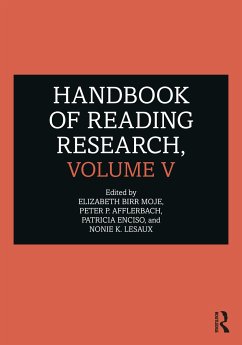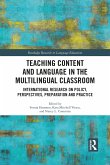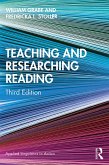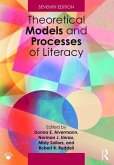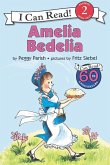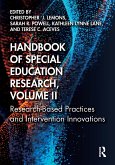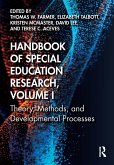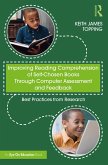- Broschiertes Buch
- Merkliste
- Auf die Merkliste
- Bewerten Bewerten
- Teilen
- Produkt teilen
- Produkterinnerung
- Produkterinnerung
In a time of pressures, challenges, and threats to public education, teacher preparation, and funding for educational research, the fifth volume of the Handbook of Reading Research takes a hard look at why we undertake reading research, how school structures, contexts and policies shape students' learning, and, most importantly, how we can realize greater impact from the research conducted. A comprehensive volume, with a "gaps and game changers" frame, this handbook not only synthesizes current reading research literature, but also informs promising directions for research, pushing readers to…mehr
Andere Kunden interessierten sich auch für
![Teaching Content and Language in the Multilingual Classroom Teaching Content and Language in the Multilingual Classroom]() Teaching Content and Language in the Multilingual Classroom41,99 €
Teaching Content and Language in the Multilingual Classroom41,99 €![Teaching and Researching Reading Teaching and Researching Reading]() William GrabeTeaching and Researching Reading42,99 €
William GrabeTeaching and Researching Reading42,99 €![Theoretical Models and Processes of Literacy Theoretical Models and Processes of Literacy]() Theoretical Models and Processes of Literacy122,99 €
Theoretical Models and Processes of Literacy122,99 €![Amelia Bedelia Amelia Bedelia]() Peggy ParishAmelia Bedelia8,49 €
Peggy ParishAmelia Bedelia8,49 €![Handbook of Special Education Research, Volume II Handbook of Special Education Research, Volume II]() Handbook of Special Education Research, Volume II121,99 €
Handbook of Special Education Research, Volume II121,99 €![Handbook of Special Education Research, Volume I Handbook of Special Education Research, Volume I]() Handbook of Special Education Research, Volume I121,99 €
Handbook of Special Education Research, Volume I121,99 €![Improving Reading Comprehension of Self-Chosen Books Through Computer Assessment and Feedback Improving Reading Comprehension of Self-Chosen Books Through Computer Assessment and Feedback]() Keith James ToppingImproving Reading Comprehension of Self-Chosen Books Through Computer Assessment and Feedback31,99 €
Keith James ToppingImproving Reading Comprehension of Self-Chosen Books Through Computer Assessment and Feedback31,99 €-
-
-
In a time of pressures, challenges, and threats to public education, teacher preparation, and funding for educational research, the fifth volume of the Handbook of Reading Research takes a hard look at why we undertake reading research, how school structures, contexts and policies shape students' learning, and, most importantly, how we can realize greater impact from the research conducted. A comprehensive volume, with a "gaps and game changers" frame, this handbook not only synthesizes current reading research literature, but also informs promising directions for research, pushing readers to address problems and challenges in research design or method.
Bringing the field authoritatively and comprehensively up-to-date since the publication of the Handbook of Reading Research, Volume IV, this volume presents multiple perspectives that will facilitate new research development, tackling topics including:
Diverse student populations and sociocultural perspectives on reading development
Digital innovation, literacies, and platforms
Conceptions of teachers, reading, readers, and texts, and the role of affect, cognition, and social-emotional learning in the reading process
New methods for researching reading instruction, with attention to equity, inclusion, and education policies
Language development and reading comprehension
Instructional practices to promote reading development and comprehension for diverse groups of readers
Each volume of this handbook has come to define the field for the period of time it covers, and this volume is no exception, providing a definitive compilation of current reading research. This is a must-have resource for all students, teachers, reading specialists, and researchers focused on and interested in reading and literacy research, and improving both instruction and programs to cultivate strong readers and teachers.
Bringing the field authoritatively and comprehensively up-to-date since the publication of the Handbook of Reading Research, Volume IV, this volume presents multiple perspectives that will facilitate new research development, tackling topics including:
Diverse student populations and sociocultural perspectives on reading development
Digital innovation, literacies, and platforms
Conceptions of teachers, reading, readers, and texts, and the role of affect, cognition, and social-emotional learning in the reading process
New methods for researching reading instruction, with attention to equity, inclusion, and education policies
Language development and reading comprehension
Instructional practices to promote reading development and comprehension for diverse groups of readers
Each volume of this handbook has come to define the field for the period of time it covers, and this volume is no exception, providing a definitive compilation of current reading research. This is a must-have resource for all students, teachers, reading specialists, and researchers focused on and interested in reading and literacy research, and improving both instruction and programs to cultivate strong readers and teachers.
Produktdetails
- Produktdetails
- Verlag: Routledge / Taylor & Francis
- Seitenzahl: 542
- Erscheinungstermin: 24. Juni 2020
- Englisch
- Abmessung: 254mm x 178mm x 29mm
- Gewicht: 957g
- ISBN-13: 9781138937376
- ISBN-10: 1138937371
- Artikelnr.: 69948669
- Herstellerkennzeichnung
- Libri GmbH
- Europaallee 1
- 36244 Bad Hersfeld
- gpsr@libri.de
- Verlag: Routledge / Taylor & Francis
- Seitenzahl: 542
- Erscheinungstermin: 24. Juni 2020
- Englisch
- Abmessung: 254mm x 178mm x 29mm
- Gewicht: 957g
- ISBN-13: 9781138937376
- ISBN-10: 1138937371
- Artikelnr.: 69948669
- Herstellerkennzeichnung
- Libri GmbH
- Europaallee 1
- 36244 Bad Hersfeld
- gpsr@libri.de
Elizabeth Birr Moje is Dean of the School of Education, George Herbert Mead Collegiate Professor of Education, an Arthur F. Thurnau Professor, and a Faculty Associate in the Institute for Social Research and Latina/o Studies at the University of Michigan, USA. Peter P. Afflerbach is Professor of Reading in the Department of Teaching and Learning, Policy and Leadership at the University of Maryland, USA. Patricia Enciso is Professor of Literacy, Literature, and Equity Studies in the Department of Teaching and Learning at the College of Education and Human Ecology, and Faculty Associate in Latinx Studies, at The Ohio State University, USA. Nonie K. Lesaux is Juliana W. and William Foss Thompson Professor of Education and Society at the Harvard Graduate School of Education, USA.
Part One: Game Changers in Reading Research: Setting the Stage
Chapter 1: Game Changers in Reading Research
Part Two: How Increasingly Diversified Populations Change the Game for Readers, Teachers, Leaders, and Reading Researchers
Chapter 2: Demographic Realities and Methodological Flexibility in Literacy Teaching and Research by C. Patrick Proctor, Chris K. Chang-Bacon
Chapter 3: Social and Cultural Diversity as Lens for Understanding Student Learning and the Development of Reading Comprehension by Carol D. Lee
Chapter 4: A Sociocultural Perspective on Readers, Reading, Reading Instruction and Assessment, Reading Policy, and Reading Research by Peter Smagorinsky, Mary Guay, Tisha Lewis Ellison, Arlette I. Willis
Part three: How Do Expanding Forms of Texts and Everyday Communication Change the Game for Readers, Teachers, Leaders, and Reading Researchers?
Chapter 5: Reading Multiple and Non-Traditional Texts: New Opportunities and New Challenges by Ivar Bråten, Jason L. G. Braasch, Ladislao Salmerón
Chapter 6: Who reads what, in which formats, and why by Margaret Mackey
Chapter 7: Digital Reading: A Research Assessment by Naomi S. Baron
Chapter 8: Multimodal Critical Inquiry: Nurturing Decolonial Imaginaries by Gerald Campano, T. Philip Nichols, Grace D. Player
Part Four: How Do Expanding Conceptualizations of Readers Change the Game
for Teachers, Leaders, and Reading Researchers?Chapter 9: The Language for School Literacy: Widening the Lens on Language and Reading Relations by Paola Uccelli, Emily Phillips Galloway, Wenjuan Qin
Chapter 10: Readers' Individual Differences in Affect and Cognition by Emily Fox
Chapter 11: Continuities Between Early Language Development and Reading Comprehension by Kiren Khan, Laura Justice
Chapter 12: What do we know today about the complexity of vocabulary gaps and what do we not know? By Jeannette Mancilla-Martinez, Janna Brown McClain
Chapter 13: The role of knowledge in understanding and learning from text by Gina N. Cervetti, Tanya S. Wright
Chapter 14: Defining Deep Reading Comprehension for Diverse Readers by Laura K. Allen, Danielle S. McNamara
Part Five: How Do Expanding Conceptions of Teacher, Reader, and Text Interaction Change the Game for Reading Researchers, Teachers, Leaders, and Policy Makers?
Chapter 15: The Joint Development of Literacy and Self-Regulation in Early Childhood: Implications for Research and Practice by Emily C. Hanno, Stephanie M. Jones, Dana C. McCoy
Chapter 16: Literacy instruction and individual differences in students' cognitive development by Jin Kyoung Hwang, Carol McDonald Connor
Chapter 17: Social and Cultural Differences in Reading Development: Instructional Processes, Learning Gains, and Challenges by Allison Skerrett
Chapter 18: Learning Academic Language, Comprehending Text by Dianna Townsend, Ana Taboada Barber, Hannah Carter
Chapter 19: High quality classroom language environments promote reading development in young children and older learners by Perla B. Gámez
Chapter 20: Expanding Teaching and Learning with Disciplinary Texts: The Case of Reading and Science by Cynthia Greenleaf, Kathleen Hinchman
Chapter 21: Literacy Instruction and Digital Innovation: Trends and Affordances for Digital Equity in Classrooms by Silvia Noguerón-Liu, Jayne C. Lammers
Chapter 22: Restorying Critical Literacies by Ebony Elizabeth Thomas, Jane Bean-Folkes, James Joshua Coleman
Chapter 23: More Connected and More Distant than Ever: Toward a Cosmopolitan Ethics of Digital Literacies by David Sabey, Kevin M. Leander
Part Six: How New Research Methods Change the Game for Reading Researchers and Policy Makers
Chapter 24: The Use of Video Data in Reading Research by Brian Rowan, Bridget Maher, Mark White
Chapter 25: Examining the Process of Reading in Media Text Environments: A Methodological Perspective by Byeong-Young Cho
Chapter 26: How Can Neuroscience Bridge Gaps in Reading Research by Kimberly G. Noble, Katrina R. Simon
Chapter 27: Qualitative Case Study Methodology Driven by Sociocultural Perspectives by Carmen M. Martínez-Roldán
Part Seven: Minding the Gaps: Translating Reading Research as the Game is Changing
Chapter 28: Concluding Thoughts from the Editors
Contributor Biographies
Chapter 1: Game Changers in Reading Research
Part Two: How Increasingly Diversified Populations Change the Game for Readers, Teachers, Leaders, and Reading Researchers
Chapter 2: Demographic Realities and Methodological Flexibility in Literacy Teaching and Research by C. Patrick Proctor, Chris K. Chang-Bacon
Chapter 3: Social and Cultural Diversity as Lens for Understanding Student Learning and the Development of Reading Comprehension by Carol D. Lee
Chapter 4: A Sociocultural Perspective on Readers, Reading, Reading Instruction and Assessment, Reading Policy, and Reading Research by Peter Smagorinsky, Mary Guay, Tisha Lewis Ellison, Arlette I. Willis
Part three: How Do Expanding Forms of Texts and Everyday Communication Change the Game for Readers, Teachers, Leaders, and Reading Researchers?
Chapter 5: Reading Multiple and Non-Traditional Texts: New Opportunities and New Challenges by Ivar Bråten, Jason L. G. Braasch, Ladislao Salmerón
Chapter 6: Who reads what, in which formats, and why by Margaret Mackey
Chapter 7: Digital Reading: A Research Assessment by Naomi S. Baron
Chapter 8: Multimodal Critical Inquiry: Nurturing Decolonial Imaginaries by Gerald Campano, T. Philip Nichols, Grace D. Player
Part Four: How Do Expanding Conceptualizations of Readers Change the Game
for Teachers, Leaders, and Reading Researchers?Chapter 9: The Language for School Literacy: Widening the Lens on Language and Reading Relations by Paola Uccelli, Emily Phillips Galloway, Wenjuan Qin
Chapter 10: Readers' Individual Differences in Affect and Cognition by Emily Fox
Chapter 11: Continuities Between Early Language Development and Reading Comprehension by Kiren Khan, Laura Justice
Chapter 12: What do we know today about the complexity of vocabulary gaps and what do we not know? By Jeannette Mancilla-Martinez, Janna Brown McClain
Chapter 13: The role of knowledge in understanding and learning from text by Gina N. Cervetti, Tanya S. Wright
Chapter 14: Defining Deep Reading Comprehension for Diverse Readers by Laura K. Allen, Danielle S. McNamara
Part Five: How Do Expanding Conceptions of Teacher, Reader, and Text Interaction Change the Game for Reading Researchers, Teachers, Leaders, and Policy Makers?
Chapter 15: The Joint Development of Literacy and Self-Regulation in Early Childhood: Implications for Research and Practice by Emily C. Hanno, Stephanie M. Jones, Dana C. McCoy
Chapter 16: Literacy instruction and individual differences in students' cognitive development by Jin Kyoung Hwang, Carol McDonald Connor
Chapter 17: Social and Cultural Differences in Reading Development: Instructional Processes, Learning Gains, and Challenges by Allison Skerrett
Chapter 18: Learning Academic Language, Comprehending Text by Dianna Townsend, Ana Taboada Barber, Hannah Carter
Chapter 19: High quality classroom language environments promote reading development in young children and older learners by Perla B. Gámez
Chapter 20: Expanding Teaching and Learning with Disciplinary Texts: The Case of Reading and Science by Cynthia Greenleaf, Kathleen Hinchman
Chapter 21: Literacy Instruction and Digital Innovation: Trends and Affordances for Digital Equity in Classrooms by Silvia Noguerón-Liu, Jayne C. Lammers
Chapter 22: Restorying Critical Literacies by Ebony Elizabeth Thomas, Jane Bean-Folkes, James Joshua Coleman
Chapter 23: More Connected and More Distant than Ever: Toward a Cosmopolitan Ethics of Digital Literacies by David Sabey, Kevin M. Leander
Part Six: How New Research Methods Change the Game for Reading Researchers and Policy Makers
Chapter 24: The Use of Video Data in Reading Research by Brian Rowan, Bridget Maher, Mark White
Chapter 25: Examining the Process of Reading in Media Text Environments: A Methodological Perspective by Byeong-Young Cho
Chapter 26: How Can Neuroscience Bridge Gaps in Reading Research by Kimberly G. Noble, Katrina R. Simon
Chapter 27: Qualitative Case Study Methodology Driven by Sociocultural Perspectives by Carmen M. Martínez-Roldán
Part Seven: Minding the Gaps: Translating Reading Research as the Game is Changing
Chapter 28: Concluding Thoughts from the Editors
Contributor Biographies
Part One: Game Changers in Reading Research: Setting the Stage
Chapter 1: Game Changers in Reading Research
Part Two: How Increasingly Diversified Populations Change the Game for
Readers, Teachers, Leaders, and Reading Researchers
Chapter 2: Demographic Realities and Methodological Flexibility in Literacy
Teaching and Research by C. Patrick Proctor, Chris K. Chang-Bacon
Chapter 3: Social and Cultural Diversity as Lens for Understanding Student
Learning and the Development of Reading Comprehension by Carol D. Lee
Chapter 4: A Sociocultural Perspective on Readers, Reading, Reading
Instruction and Assessment, Reading Policy, and Reading Research by Peter
Smagorinsky, Mary Guay, Tisha Lewis Ellison, Arlette I. Willis
Part three: How Do Expanding Forms of Texts and Everyday Communication
Change the Game for Readers, Teachers, Leaders, and Reading Researchers?
Chapter 5: Reading Multiple and Non-Traditional Texts: New Opportunities
and New Challenges by Ivar Bråten, Jason L. G. Braasch, Ladislao Salmerón
Chapter 6: Who reads what, in which formats, and why by Margaret Mackey
Chapter 7: Digital Reading: A Research Assessment by Naomi S. Baron
Chapter 8: Multimodal Critical Inquiry: Nurturing Decolonial Imaginaries by
Gerald Campano, T. Philip Nichols, Grace D. Player
Part Four: How Do Expanding Conceptualizations of Readers Change the Game
for Teachers, Leaders, and Reading Researchers?Chapter 9: The Language for
School Literacy: Widening the Lens on Language and Reading Relations by
Paola Uccelli, Emily Phillips Galloway, Wenjuan Qin
Chapter 10: Readers' Individual Differences in Affect and Cognition by
Emily Fox
Chapter 11: Continuities Between Early Language Development and Reading
Comprehension by Kiren Khan, Laura Justice
Chapter 12: What do we know today about the complexity of vocabulary gaps
and what do we not know? By Jeannette Mancilla-Martinez, Janna Brown
McClain
Chapter 13: The role of knowledge in understanding and learning from text
by Gina N. Cervetti, Tanya S. Wright
Chapter 14: Defining Deep Reading Comprehension for Diverse Readers by
Laura K. Allen, Danielle S. McNamara
Part Five: How Do Expanding Conceptions of Teacher, Reader, and Text
Interaction Change the Game for Reading Researchers, Teachers, Leaders, and
Policy Makers?
Chapter 15: The Joint Development of Literacy and Self-Regulation in Early
Childhood: Implications for Research and Practice by Emily C. Hanno,
Stephanie M. Jones, Dana C. McCoy
Chapter 16: Literacy instruction and individual differences in students'
cognitive development by Jin Kyoung Hwang, Carol McDonald Connor
Chapter 17: Social and Cultural Differences in Reading Development:
Instructional Processes, Learning Gains, and Challenges by Allison Skerrett
Chapter 18: Learning Academic Language, Comprehending Text by Dianna
Townsend, Ana Taboada Barber, Hannah Carter
Chapter 19: High quality classroom language environments promote reading
development in young children and older learners by Perla B. Gámez
Chapter 20: Expanding Teaching and Learning with Disciplinary Texts: The
Case of Reading and Science by Cynthia Greenleaf, Kathleen Hinchman
Chapter 21: Literacy Instruction and Digital Innovation: Trends and
Affordances for Digital Equity in Classrooms by Silvia Noguerón-Liu, Jayne
C. Lammers
Chapter 22: Restorying Critical Literacies by Ebony Elizabeth Thomas, Jane
Bean-Folkes, James Joshua Coleman
Chapter 23: More Connected and More Distant than Ever: Toward a
Cosmopolitan Ethics of Digital Literacies by David Sabey, Kevin M. Leander
Part Six: How New Research Methods Change the Game for Reading Researchers
and Policy Makers
Chapter 24: The Use of Video Data in Reading Research by Brian Rowan,
Bridget Maher, Mark White
Chapter 25: Examining the Process of Reading in Media Text Environments: A
Methodological Perspective by Byeong-Young Cho
Chapter 26: How Can Neuroscience Bridge Gaps in Reading Research by
Kimberly G. Noble, Katrina R. Simon
Chapter 27: Qualitative Case Study Methodology Driven by Sociocultural
Perspectives by Carmen M. Martínez-Roldán
Part Seven: Minding the Gaps: Translating Reading Research as the Game is
Changing
Chapter 28: Concluding Thoughts from the Editors
Contributor Biographies
Chapter 1: Game Changers in Reading Research
Part Two: How Increasingly Diversified Populations Change the Game for
Readers, Teachers, Leaders, and Reading Researchers
Chapter 2: Demographic Realities and Methodological Flexibility in Literacy
Teaching and Research by C. Patrick Proctor, Chris K. Chang-Bacon
Chapter 3: Social and Cultural Diversity as Lens for Understanding Student
Learning and the Development of Reading Comprehension by Carol D. Lee
Chapter 4: A Sociocultural Perspective on Readers, Reading, Reading
Instruction and Assessment, Reading Policy, and Reading Research by Peter
Smagorinsky, Mary Guay, Tisha Lewis Ellison, Arlette I. Willis
Part three: How Do Expanding Forms of Texts and Everyday Communication
Change the Game for Readers, Teachers, Leaders, and Reading Researchers?
Chapter 5: Reading Multiple and Non-Traditional Texts: New Opportunities
and New Challenges by Ivar Bråten, Jason L. G. Braasch, Ladislao Salmerón
Chapter 6: Who reads what, in which formats, and why by Margaret Mackey
Chapter 7: Digital Reading: A Research Assessment by Naomi S. Baron
Chapter 8: Multimodal Critical Inquiry: Nurturing Decolonial Imaginaries by
Gerald Campano, T. Philip Nichols, Grace D. Player
Part Four: How Do Expanding Conceptualizations of Readers Change the Game
for Teachers, Leaders, and Reading Researchers?Chapter 9: The Language for
School Literacy: Widening the Lens on Language and Reading Relations by
Paola Uccelli, Emily Phillips Galloway, Wenjuan Qin
Chapter 10: Readers' Individual Differences in Affect and Cognition by
Emily Fox
Chapter 11: Continuities Between Early Language Development and Reading
Comprehension by Kiren Khan, Laura Justice
Chapter 12: What do we know today about the complexity of vocabulary gaps
and what do we not know? By Jeannette Mancilla-Martinez, Janna Brown
McClain
Chapter 13: The role of knowledge in understanding and learning from text
by Gina N. Cervetti, Tanya S. Wright
Chapter 14: Defining Deep Reading Comprehension for Diverse Readers by
Laura K. Allen, Danielle S. McNamara
Part Five: How Do Expanding Conceptions of Teacher, Reader, and Text
Interaction Change the Game for Reading Researchers, Teachers, Leaders, and
Policy Makers?
Chapter 15: The Joint Development of Literacy and Self-Regulation in Early
Childhood: Implications for Research and Practice by Emily C. Hanno,
Stephanie M. Jones, Dana C. McCoy
Chapter 16: Literacy instruction and individual differences in students'
cognitive development by Jin Kyoung Hwang, Carol McDonald Connor
Chapter 17: Social and Cultural Differences in Reading Development:
Instructional Processes, Learning Gains, and Challenges by Allison Skerrett
Chapter 18: Learning Academic Language, Comprehending Text by Dianna
Townsend, Ana Taboada Barber, Hannah Carter
Chapter 19: High quality classroom language environments promote reading
development in young children and older learners by Perla B. Gámez
Chapter 20: Expanding Teaching and Learning with Disciplinary Texts: The
Case of Reading and Science by Cynthia Greenleaf, Kathleen Hinchman
Chapter 21: Literacy Instruction and Digital Innovation: Trends and
Affordances for Digital Equity in Classrooms by Silvia Noguerón-Liu, Jayne
C. Lammers
Chapter 22: Restorying Critical Literacies by Ebony Elizabeth Thomas, Jane
Bean-Folkes, James Joshua Coleman
Chapter 23: More Connected and More Distant than Ever: Toward a
Cosmopolitan Ethics of Digital Literacies by David Sabey, Kevin M. Leander
Part Six: How New Research Methods Change the Game for Reading Researchers
and Policy Makers
Chapter 24: The Use of Video Data in Reading Research by Brian Rowan,
Bridget Maher, Mark White
Chapter 25: Examining the Process of Reading in Media Text Environments: A
Methodological Perspective by Byeong-Young Cho
Chapter 26: How Can Neuroscience Bridge Gaps in Reading Research by
Kimberly G. Noble, Katrina R. Simon
Chapter 27: Qualitative Case Study Methodology Driven by Sociocultural
Perspectives by Carmen M. Martínez-Roldán
Part Seven: Minding the Gaps: Translating Reading Research as the Game is
Changing
Chapter 28: Concluding Thoughts from the Editors
Contributor Biographies
Part One: Game Changers in Reading Research: Setting the Stage
Chapter 1: Game Changers in Reading Research
Part Two: How Increasingly Diversified Populations Change the Game for Readers, Teachers, Leaders, and Reading Researchers
Chapter 2: Demographic Realities and Methodological Flexibility in Literacy Teaching and Research by C. Patrick Proctor, Chris K. Chang-Bacon
Chapter 3: Social and Cultural Diversity as Lens for Understanding Student Learning and the Development of Reading Comprehension by Carol D. Lee
Chapter 4: A Sociocultural Perspective on Readers, Reading, Reading Instruction and Assessment, Reading Policy, and Reading Research by Peter Smagorinsky, Mary Guay, Tisha Lewis Ellison, Arlette I. Willis
Part three: How Do Expanding Forms of Texts and Everyday Communication Change the Game for Readers, Teachers, Leaders, and Reading Researchers?
Chapter 5: Reading Multiple and Non-Traditional Texts: New Opportunities and New Challenges by Ivar Bråten, Jason L. G. Braasch, Ladislao Salmerón
Chapter 6: Who reads what, in which formats, and why by Margaret Mackey
Chapter 7: Digital Reading: A Research Assessment by Naomi S. Baron
Chapter 8: Multimodal Critical Inquiry: Nurturing Decolonial Imaginaries by Gerald Campano, T. Philip Nichols, Grace D. Player
Part Four: How Do Expanding Conceptualizations of Readers Change the Game
for Teachers, Leaders, and Reading Researchers?Chapter 9: The Language for School Literacy: Widening the Lens on Language and Reading Relations by Paola Uccelli, Emily Phillips Galloway, Wenjuan Qin
Chapter 10: Readers' Individual Differences in Affect and Cognition by Emily Fox
Chapter 11: Continuities Between Early Language Development and Reading Comprehension by Kiren Khan, Laura Justice
Chapter 12: What do we know today about the complexity of vocabulary gaps and what do we not know? By Jeannette Mancilla-Martinez, Janna Brown McClain
Chapter 13: The role of knowledge in understanding and learning from text by Gina N. Cervetti, Tanya S. Wright
Chapter 14: Defining Deep Reading Comprehension for Diverse Readers by Laura K. Allen, Danielle S. McNamara
Part Five: How Do Expanding Conceptions of Teacher, Reader, and Text Interaction Change the Game for Reading Researchers, Teachers, Leaders, and Policy Makers?
Chapter 15: The Joint Development of Literacy and Self-Regulation in Early Childhood: Implications for Research and Practice by Emily C. Hanno, Stephanie M. Jones, Dana C. McCoy
Chapter 16: Literacy instruction and individual differences in students' cognitive development by Jin Kyoung Hwang, Carol McDonald Connor
Chapter 17: Social and Cultural Differences in Reading Development: Instructional Processes, Learning Gains, and Challenges by Allison Skerrett
Chapter 18: Learning Academic Language, Comprehending Text by Dianna Townsend, Ana Taboada Barber, Hannah Carter
Chapter 19: High quality classroom language environments promote reading development in young children and older learners by Perla B. Gámez
Chapter 20: Expanding Teaching and Learning with Disciplinary Texts: The Case of Reading and Science by Cynthia Greenleaf, Kathleen Hinchman
Chapter 21: Literacy Instruction and Digital Innovation: Trends and Affordances for Digital Equity in Classrooms by Silvia Noguerón-Liu, Jayne C. Lammers
Chapter 22: Restorying Critical Literacies by Ebony Elizabeth Thomas, Jane Bean-Folkes, James Joshua Coleman
Chapter 23: More Connected and More Distant than Ever: Toward a Cosmopolitan Ethics of Digital Literacies by David Sabey, Kevin M. Leander
Part Six: How New Research Methods Change the Game for Reading Researchers and Policy Makers
Chapter 24: The Use of Video Data in Reading Research by Brian Rowan, Bridget Maher, Mark White
Chapter 25: Examining the Process of Reading in Media Text Environments: A Methodological Perspective by Byeong-Young Cho
Chapter 26: How Can Neuroscience Bridge Gaps in Reading Research by Kimberly G. Noble, Katrina R. Simon
Chapter 27: Qualitative Case Study Methodology Driven by Sociocultural Perspectives by Carmen M. Martínez-Roldán
Part Seven: Minding the Gaps: Translating Reading Research as the Game is Changing
Chapter 28: Concluding Thoughts from the Editors
Contributor Biographies
Chapter 1: Game Changers in Reading Research
Part Two: How Increasingly Diversified Populations Change the Game for Readers, Teachers, Leaders, and Reading Researchers
Chapter 2: Demographic Realities and Methodological Flexibility in Literacy Teaching and Research by C. Patrick Proctor, Chris K. Chang-Bacon
Chapter 3: Social and Cultural Diversity as Lens for Understanding Student Learning and the Development of Reading Comprehension by Carol D. Lee
Chapter 4: A Sociocultural Perspective on Readers, Reading, Reading Instruction and Assessment, Reading Policy, and Reading Research by Peter Smagorinsky, Mary Guay, Tisha Lewis Ellison, Arlette I. Willis
Part three: How Do Expanding Forms of Texts and Everyday Communication Change the Game for Readers, Teachers, Leaders, and Reading Researchers?
Chapter 5: Reading Multiple and Non-Traditional Texts: New Opportunities and New Challenges by Ivar Bråten, Jason L. G. Braasch, Ladislao Salmerón
Chapter 6: Who reads what, in which formats, and why by Margaret Mackey
Chapter 7: Digital Reading: A Research Assessment by Naomi S. Baron
Chapter 8: Multimodal Critical Inquiry: Nurturing Decolonial Imaginaries by Gerald Campano, T. Philip Nichols, Grace D. Player
Part Four: How Do Expanding Conceptualizations of Readers Change the Game
for Teachers, Leaders, and Reading Researchers?Chapter 9: The Language for School Literacy: Widening the Lens on Language and Reading Relations by Paola Uccelli, Emily Phillips Galloway, Wenjuan Qin
Chapter 10: Readers' Individual Differences in Affect and Cognition by Emily Fox
Chapter 11: Continuities Between Early Language Development and Reading Comprehension by Kiren Khan, Laura Justice
Chapter 12: What do we know today about the complexity of vocabulary gaps and what do we not know? By Jeannette Mancilla-Martinez, Janna Brown McClain
Chapter 13: The role of knowledge in understanding and learning from text by Gina N. Cervetti, Tanya S. Wright
Chapter 14: Defining Deep Reading Comprehension for Diverse Readers by Laura K. Allen, Danielle S. McNamara
Part Five: How Do Expanding Conceptions of Teacher, Reader, and Text Interaction Change the Game for Reading Researchers, Teachers, Leaders, and Policy Makers?
Chapter 15: The Joint Development of Literacy and Self-Regulation in Early Childhood: Implications for Research and Practice by Emily C. Hanno, Stephanie M. Jones, Dana C. McCoy
Chapter 16: Literacy instruction and individual differences in students' cognitive development by Jin Kyoung Hwang, Carol McDonald Connor
Chapter 17: Social and Cultural Differences in Reading Development: Instructional Processes, Learning Gains, and Challenges by Allison Skerrett
Chapter 18: Learning Academic Language, Comprehending Text by Dianna Townsend, Ana Taboada Barber, Hannah Carter
Chapter 19: High quality classroom language environments promote reading development in young children and older learners by Perla B. Gámez
Chapter 20: Expanding Teaching and Learning with Disciplinary Texts: The Case of Reading and Science by Cynthia Greenleaf, Kathleen Hinchman
Chapter 21: Literacy Instruction and Digital Innovation: Trends and Affordances for Digital Equity in Classrooms by Silvia Noguerón-Liu, Jayne C. Lammers
Chapter 22: Restorying Critical Literacies by Ebony Elizabeth Thomas, Jane Bean-Folkes, James Joshua Coleman
Chapter 23: More Connected and More Distant than Ever: Toward a Cosmopolitan Ethics of Digital Literacies by David Sabey, Kevin M. Leander
Part Six: How New Research Methods Change the Game for Reading Researchers and Policy Makers
Chapter 24: The Use of Video Data in Reading Research by Brian Rowan, Bridget Maher, Mark White
Chapter 25: Examining the Process of Reading in Media Text Environments: A Methodological Perspective by Byeong-Young Cho
Chapter 26: How Can Neuroscience Bridge Gaps in Reading Research by Kimberly G. Noble, Katrina R. Simon
Chapter 27: Qualitative Case Study Methodology Driven by Sociocultural Perspectives by Carmen M. Martínez-Roldán
Part Seven: Minding the Gaps: Translating Reading Research as the Game is Changing
Chapter 28: Concluding Thoughts from the Editors
Contributor Biographies
Part One: Game Changers in Reading Research: Setting the Stage
Chapter 1: Game Changers in Reading Research
Part Two: How Increasingly Diversified Populations Change the Game for
Readers, Teachers, Leaders, and Reading Researchers
Chapter 2: Demographic Realities and Methodological Flexibility in Literacy
Teaching and Research by C. Patrick Proctor, Chris K. Chang-Bacon
Chapter 3: Social and Cultural Diversity as Lens for Understanding Student
Learning and the Development of Reading Comprehension by Carol D. Lee
Chapter 4: A Sociocultural Perspective on Readers, Reading, Reading
Instruction and Assessment, Reading Policy, and Reading Research by Peter
Smagorinsky, Mary Guay, Tisha Lewis Ellison, Arlette I. Willis
Part three: How Do Expanding Forms of Texts and Everyday Communication
Change the Game for Readers, Teachers, Leaders, and Reading Researchers?
Chapter 5: Reading Multiple and Non-Traditional Texts: New Opportunities
and New Challenges by Ivar Bråten, Jason L. G. Braasch, Ladislao Salmerón
Chapter 6: Who reads what, in which formats, and why by Margaret Mackey
Chapter 7: Digital Reading: A Research Assessment by Naomi S. Baron
Chapter 8: Multimodal Critical Inquiry: Nurturing Decolonial Imaginaries by
Gerald Campano, T. Philip Nichols, Grace D. Player
Part Four: How Do Expanding Conceptualizations of Readers Change the Game
for Teachers, Leaders, and Reading Researchers?Chapter 9: The Language for
School Literacy: Widening the Lens on Language and Reading Relations by
Paola Uccelli, Emily Phillips Galloway, Wenjuan Qin
Chapter 10: Readers' Individual Differences in Affect and Cognition by
Emily Fox
Chapter 11: Continuities Between Early Language Development and Reading
Comprehension by Kiren Khan, Laura Justice
Chapter 12: What do we know today about the complexity of vocabulary gaps
and what do we not know? By Jeannette Mancilla-Martinez, Janna Brown
McClain
Chapter 13: The role of knowledge in understanding and learning from text
by Gina N. Cervetti, Tanya S. Wright
Chapter 14: Defining Deep Reading Comprehension for Diverse Readers by
Laura K. Allen, Danielle S. McNamara
Part Five: How Do Expanding Conceptions of Teacher, Reader, and Text
Interaction Change the Game for Reading Researchers, Teachers, Leaders, and
Policy Makers?
Chapter 15: The Joint Development of Literacy and Self-Regulation in Early
Childhood: Implications for Research and Practice by Emily C. Hanno,
Stephanie M. Jones, Dana C. McCoy
Chapter 16: Literacy instruction and individual differences in students'
cognitive development by Jin Kyoung Hwang, Carol McDonald Connor
Chapter 17: Social and Cultural Differences in Reading Development:
Instructional Processes, Learning Gains, and Challenges by Allison Skerrett
Chapter 18: Learning Academic Language, Comprehending Text by Dianna
Townsend, Ana Taboada Barber, Hannah Carter
Chapter 19: High quality classroom language environments promote reading
development in young children and older learners by Perla B. Gámez
Chapter 20: Expanding Teaching and Learning with Disciplinary Texts: The
Case of Reading and Science by Cynthia Greenleaf, Kathleen Hinchman
Chapter 21: Literacy Instruction and Digital Innovation: Trends and
Affordances for Digital Equity in Classrooms by Silvia Noguerón-Liu, Jayne
C. Lammers
Chapter 22: Restorying Critical Literacies by Ebony Elizabeth Thomas, Jane
Bean-Folkes, James Joshua Coleman
Chapter 23: More Connected and More Distant than Ever: Toward a
Cosmopolitan Ethics of Digital Literacies by David Sabey, Kevin M. Leander
Part Six: How New Research Methods Change the Game for Reading Researchers
and Policy Makers
Chapter 24: The Use of Video Data in Reading Research by Brian Rowan,
Bridget Maher, Mark White
Chapter 25: Examining the Process of Reading in Media Text Environments: A
Methodological Perspective by Byeong-Young Cho
Chapter 26: How Can Neuroscience Bridge Gaps in Reading Research by
Kimberly G. Noble, Katrina R. Simon
Chapter 27: Qualitative Case Study Methodology Driven by Sociocultural
Perspectives by Carmen M. Martínez-Roldán
Part Seven: Minding the Gaps: Translating Reading Research as the Game is
Changing
Chapter 28: Concluding Thoughts from the Editors
Contributor Biographies
Chapter 1: Game Changers in Reading Research
Part Two: How Increasingly Diversified Populations Change the Game for
Readers, Teachers, Leaders, and Reading Researchers
Chapter 2: Demographic Realities and Methodological Flexibility in Literacy
Teaching and Research by C. Patrick Proctor, Chris K. Chang-Bacon
Chapter 3: Social and Cultural Diversity as Lens for Understanding Student
Learning and the Development of Reading Comprehension by Carol D. Lee
Chapter 4: A Sociocultural Perspective on Readers, Reading, Reading
Instruction and Assessment, Reading Policy, and Reading Research by Peter
Smagorinsky, Mary Guay, Tisha Lewis Ellison, Arlette I. Willis
Part three: How Do Expanding Forms of Texts and Everyday Communication
Change the Game for Readers, Teachers, Leaders, and Reading Researchers?
Chapter 5: Reading Multiple and Non-Traditional Texts: New Opportunities
and New Challenges by Ivar Bråten, Jason L. G. Braasch, Ladislao Salmerón
Chapter 6: Who reads what, in which formats, and why by Margaret Mackey
Chapter 7: Digital Reading: A Research Assessment by Naomi S. Baron
Chapter 8: Multimodal Critical Inquiry: Nurturing Decolonial Imaginaries by
Gerald Campano, T. Philip Nichols, Grace D. Player
Part Four: How Do Expanding Conceptualizations of Readers Change the Game
for Teachers, Leaders, and Reading Researchers?Chapter 9: The Language for
School Literacy: Widening the Lens on Language and Reading Relations by
Paola Uccelli, Emily Phillips Galloway, Wenjuan Qin
Chapter 10: Readers' Individual Differences in Affect and Cognition by
Emily Fox
Chapter 11: Continuities Between Early Language Development and Reading
Comprehension by Kiren Khan, Laura Justice
Chapter 12: What do we know today about the complexity of vocabulary gaps
and what do we not know? By Jeannette Mancilla-Martinez, Janna Brown
McClain
Chapter 13: The role of knowledge in understanding and learning from text
by Gina N. Cervetti, Tanya S. Wright
Chapter 14: Defining Deep Reading Comprehension for Diverse Readers by
Laura K. Allen, Danielle S. McNamara
Part Five: How Do Expanding Conceptions of Teacher, Reader, and Text
Interaction Change the Game for Reading Researchers, Teachers, Leaders, and
Policy Makers?
Chapter 15: The Joint Development of Literacy and Self-Regulation in Early
Childhood: Implications for Research and Practice by Emily C. Hanno,
Stephanie M. Jones, Dana C. McCoy
Chapter 16: Literacy instruction and individual differences in students'
cognitive development by Jin Kyoung Hwang, Carol McDonald Connor
Chapter 17: Social and Cultural Differences in Reading Development:
Instructional Processes, Learning Gains, and Challenges by Allison Skerrett
Chapter 18: Learning Academic Language, Comprehending Text by Dianna
Townsend, Ana Taboada Barber, Hannah Carter
Chapter 19: High quality classroom language environments promote reading
development in young children and older learners by Perla B. Gámez
Chapter 20: Expanding Teaching and Learning with Disciplinary Texts: The
Case of Reading and Science by Cynthia Greenleaf, Kathleen Hinchman
Chapter 21: Literacy Instruction and Digital Innovation: Trends and
Affordances for Digital Equity in Classrooms by Silvia Noguerón-Liu, Jayne
C. Lammers
Chapter 22: Restorying Critical Literacies by Ebony Elizabeth Thomas, Jane
Bean-Folkes, James Joshua Coleman
Chapter 23: More Connected and More Distant than Ever: Toward a
Cosmopolitan Ethics of Digital Literacies by David Sabey, Kevin M. Leander
Part Six: How New Research Methods Change the Game for Reading Researchers
and Policy Makers
Chapter 24: The Use of Video Data in Reading Research by Brian Rowan,
Bridget Maher, Mark White
Chapter 25: Examining the Process of Reading in Media Text Environments: A
Methodological Perspective by Byeong-Young Cho
Chapter 26: How Can Neuroscience Bridge Gaps in Reading Research by
Kimberly G. Noble, Katrina R. Simon
Chapter 27: Qualitative Case Study Methodology Driven by Sociocultural
Perspectives by Carmen M. Martínez-Roldán
Part Seven: Minding the Gaps: Translating Reading Research as the Game is
Changing
Chapter 28: Concluding Thoughts from the Editors
Contributor Biographies

